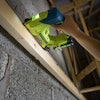
Pilots of an airliner that crashed last month in Ethiopia initially followed Boeing's emergency steps by disconnecting a system that can force the nose of the plane down, but they could not regain control.
Data from the plane indicates that the pilots then broke from Boeing recommendations by reconnecting power to the system, according to an official familiar with the crash investigation.
The official spoke on condition of anonymity because a preliminary report on the March 10 crash has not yet been made public. Ethiopian investigators are expected to release the report on Thursday.
News that pilots of the Ethiopian Airlines Boeing 737 Max turned off a critical flight-control system suspected of playing a role in an earlier crash of the same model was first reported by the Wall Street Journal.
The newspaper said the pilots' actions are still being evaluated by investigators but could raise questions about assertions by Boeing and U.S. regulators last year that pilots could regain control in some emergencies by following steps that include turning off an anti-stall system designed specifically for the Max.
In a statement, Boeing urged against speculating before the preliminary report and flight data from the plane are released.
Investigators are examining the crashes that killed all 346 people aboard the two Max 8 jets, which were operated by Lion Air, an Indonesia carrier, and Ethiopian Airlines. They are looking into the role of a flight-control system known by its acronym, MCAS, which under some circumstances can automatically lower the plane's nose to prevent an aerodynamic stall.
The Max has been grounded worldwide pending a software fix that Boeing is rolling out, which must still receive approval from the Federal Aviation Administration and other regulators.
The official who discussed the matter with The Associated Press said that data downloaded from the plane's so-called black boxes indicates that the pilots of Ethiopian Airlines Flight 302 followed recommendations by flipping two switches that disconnected power to the system. Sources told the Journal that despite that step, the pilots could not make the plane climb.
The pilots then reversed the power switches that they had turned off — a step not included in Boeing-approved recovery procedures — which reactivated MCAS and pushed the plane's nose down, the official told the AP. Boeing's procedures instruct pilots to leave the MCAS system disconnected and continue flying manually for the rest of the flight.
Boeing developed MCAS for the Max because the plane has larger engines that sit higher and more forward under the wings than the engines on previous 737s, which gives the new model a greater tendency for the nose to tip upward in some situations.
John Goglia, a former member of the National Transportation Safety Board, said MCAS was designed largely to reduce the nose-up effect during takeoff and avoid a dangerous aerodynamic stall, or loss of lift from air flowing over the wings.
Pilots can turn off MCAS by pressing a button on their control column, although the system can resume if pressure is released. If pilots opt instead to disable the system by flipping a pair of toggle switches, it cuts power to part of the tail called a horizontal stabilizer used to point the plane up or down. Flipping the switches requires pilots to manually turn a wheel to operate the stabilizer.
"The pilot not flying should be cranking that wheel," Goglia said.
If the Ethiopian pilots followed all of Boeing's procedures and disengaged the MCAS but the plane still crashed, the company has some explaining to do, he said. But, he added, restoring power to the system "is not in the procedure."
Boeing is the focus of investigations by the Justice Department, the Transportation Department's inspector general, and congressional committees. Investigations are also looking at the role of the Federal Aviation Administration, which certified the Max in 2017 and declined to ground it after the first deadly crash in October.






















